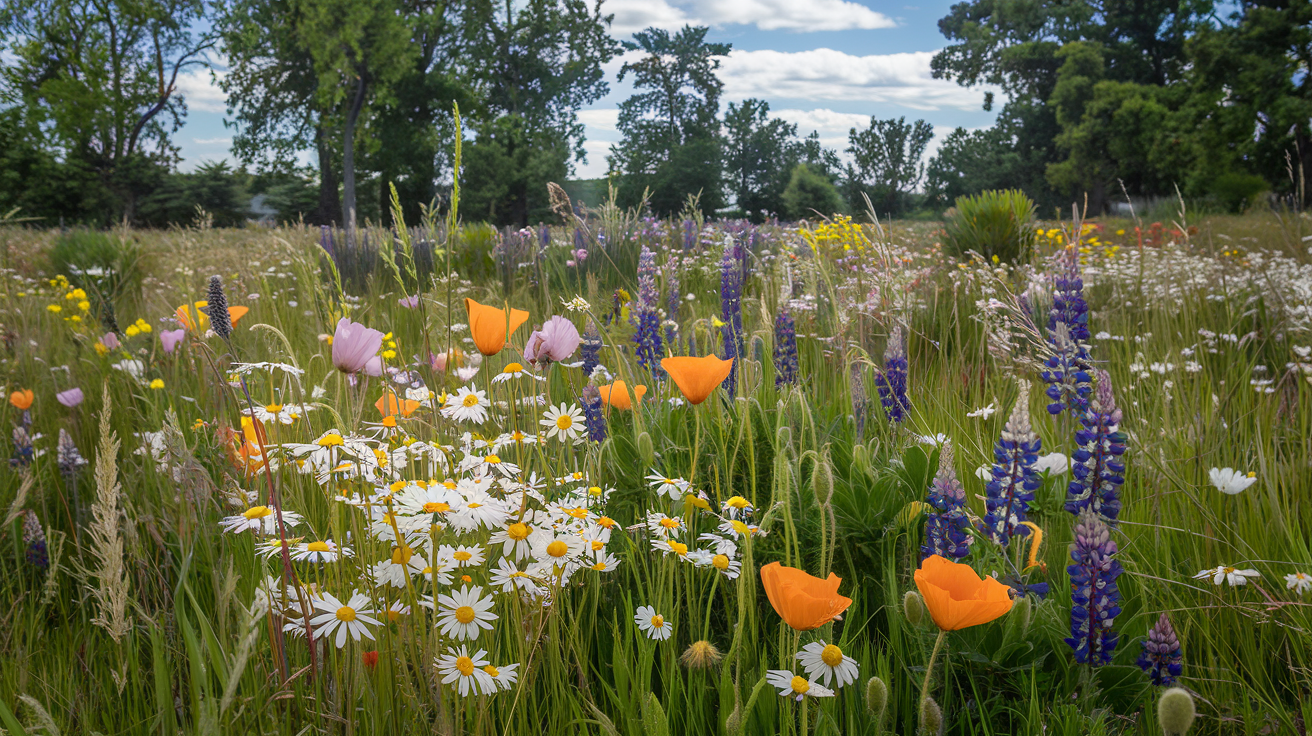Wildflowers are a beautiful and resilient addition to any garden, but many gardeners wonder if they are perennial. In this brief guide, Rhys Garden will clarify whether wildflowers can return year after year, adding lasting beauty to your landscape.
Understanding Wild Flowers
Wildflowers, also known as wildflowers or native plants, are those species that grow naturally in their native habitats without human intervention. These resilient plants have adapted to local conditions over thousands of years, making them an essential part of our ecosystems. But when it comes to their life cycles, wildflowers display a fascinating diversity that captivates both botanists and casual gardeners alike.
Wildflowers can be annual, biennial, or perennial, each with its unique growth pattern and life cycle. Let’s break down these categories to better understand the nature of wildflowers:
- Annual Wild Flowers: These complete their life cycle in one growing season. They germinate, grow, flower, set seed, and die within a year.
- Biennial Wild Flowers: These plants take two years to complete their life cycle. In the first year, they grow leaves and roots, and in the second year, they flower, set seed, and then die.
- Perennial Wild Flowers: These plants live for more than two years, often returning season after season from their root systems.
The Perennial Nature of Many Wild Flowers
While not all wildflowers are perennial, a significant number of species do fall into this category. Perennial wildflowers have developed various strategies to survive harsh conditions and return year after year, bringing joy to gardens and natural landscapes alike.
Perennial wildflowers possess several traits that contribute to their longevity:
- Deep Root Systems: Many perennial wildflowers develop extensive root networks that allow them to access water and nutrients deep in the soil.
- Energy Storage: These plants often store energy in their roots, rhizomes, or bulbs, enabling them to regrow even after their above-ground parts die back.
- Adaptability: Perennial wildflowers have evolved to withstand various environmental stresses, from drought to extreme temperatures.
- Slow Growth: Some perennial species invest energy in slow, steady growth rather than rapid expansion, contributing to their long-term survival.
Common Perennial Wild Flowers
Let’s explore some popular perennial wildflowers that grace gardens and meadows with their recurring beauty:
- Black-Eyed Susan (Rudbeckia hirta)
- Purple Coneflower (Echinacea purpurea)
- Butterfly Weed (Asclepias tuberosa)
- Wild Columbine (Aquilegia canadensis)
- Blazing Star (Liatris spicata)
These hardy perennials not only provide recurring beauty but also support local ecosystems by attracting pollinators and wildlife.
The Benefits of Perennial Wild Flowers in Your Garden

Incorporating perennial wildflowers into your garden landscape offers numerous advantages:
- Low Maintenance: Once established, perennial wildflowers require minimal care, making them ideal for busy gardeners.
- Cost-Effective: Since they return year after year, perennials offer excellent value for money compared to annuals that need replanting each season.
- Eco-Friendly: Native perennial wildflowers support local wildlife and contribute to biodiversity.
- Seasonal Interest: Different species bloom at various times, providing year-round visual appeal.
- Drought Tolerance: Many perennial wildflowers are adapted to local conditions and can withstand periods of drought.
Cultivating Perennial Wild Flowers: Tips for Success
To ensure your perennial wildflowers thrive and return year after year, consider these gardening tips:
- Choose Native Species: Select wildflowers native to your region for the best chance of success.
- Prepare the Soil: Most wildflowers prefer well-draining soil. Amend heavy clay or sandy soils as needed.
- Provide Adequate Sunlight: Most wildflowers thrive in full sun, but some species prefer partial shade.
- Water Wisely: While established perennials are often drought-tolerant, they may need supplemental watering during dry spells, especially in their first year.
- Avoid Over-Fertilizing: Wildflowers are adapted to less fertile soils. Excessive nutrients can lead to weak growth and fewer blooms.
- Practice Patience: Perennial wildflowers may take a few seasons to establish fully and reach their full blooming potential.
The Role of Perennial Wild Flowers in Ecosystem Health
Perennial wildflowers play a crucial role in maintaining healthy ecosystems:
- Pollinator Support: They provide essential nectar and pollen for bees, butterflies, and other pollinators.
- Erosion Control: Deep root systems help prevent soil erosion and improve soil structure.
- Habitat Creation: Wildflowers offer shelter and food for various wildlife species.
- Carbon Sequestration: Perennial plants store carbon in their roots and soil, contributing to climate change mitigation.
Challenges in Growing Perennial Wild Flowers
While perennial wildflowers offer many benefits, they can present some challenges:
- Invasive Potential: Some species can spread aggressively and may need to be controlled.
- Slow Establishment: Perennials may take longer to establish compared to annuals, requiring patience from gardeners.
- Specific Growing Conditions: Some wildflowers have very particular soil or light requirements that may be challenging to meet in certain gardens.
- Competition: In natural settings, wildflowers may face competition from more aggressive plants, including invasive species.
Frequently Asked Questions About Perennial Wild Flowers
Q1: How long do perennial wildflowers typically live?
A1: The lifespan of perennial wildflowers varies greatly depending on the species. Some may live for just a few years, while others can persist for decades under the right conditions. For example, the Black-Eyed Susan (Rudbeckia hirta) typically lives for 2-3 years, while the Purple Coneflower (Echinacea purpurea) can live for up to 20 years or more.
Q2: Do all perennial wildflowers bloom every year?
A2: Not necessarily. Some perennial wildflowers may not bloom in their first year as they establish their root systems. Others may have cyclical blooming patterns, flowering heavily one year and less so the next. Factors such as weather conditions, soil health, and competition can also affect blooming frequency.
Q3: Can I grow perennial wildflowers in containers?
A3: Yes, many perennial wildflowers can be successfully grown in containers. Choose species that are appropriate for the container size and ensure proper drainage. Some good candidates for container growing include Wild Columbine (Aquilegia canadensis) and Blazing Star (Liatris spicata).
Q4: How do I know if a wildflower is annual or perennial?
A4: Research is key. Consult reliable gardening resources or native plant guides for your region. You can also observe the plant’s growth pattern over time. Perennials will typically regrow from the same root system year after year, while annuals will not return after setting seed and dying.
Q5: Are all native plants considered wildflowers?
A5: While many native plants are considered wildflowers, not all are. The term “wildflower” generally refers to herbaceous (non-woody) flowering plants that grow without cultivation. Trees, shrubs, and grasses, although they may be native, are typically not classified as wildflowers.
The Future of Perennial Wild Flowers in Horticulture
As interest in sustainable and eco-friendly gardening practices grows, perennial wildflowers are likely to play an increasingly important role in both home gardens and public landscapes. Here are some trends and developments to watch:
- Native Plant Movements: There’s a growing emphasis on using native plants, including perennial wildflowers, in landscaping to support local ecosystems.
- Urban Meadows: Cities are increasingly incorporating wildflower meadows into urban green spaces, providing habitat for pollinators and reducing maintenance costs.
- Climate Adaptation: As climate change affects growing conditions, hardy perennial wildflowers may become more valued for their resilience.
- Breeding Programs: Horticulturists are developing new cultivars of wildflowers that retain their native characteristics while offering improved garden performance.
- Education and Outreach: Botanical gardens and conservation organizations are increasing efforts to educate the public about the importance of perennial wildflowers in ecosystem health.
Conclusion
While some wildflowers are perennial, others are annual or biennial. By choosing the right varieties, you can enjoy their natural charm for multiple seasons, creating a garden that blooms beautifully year after year.

Related Posts
Growing Johnny Jump Up Seeds: A Gardener’s Guide to Viola Tricolor
The Art of Transplanting Japanese Maple
Designer Garden Gate With Pergola: Elevate Your Garden Entrance